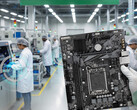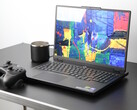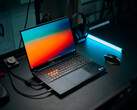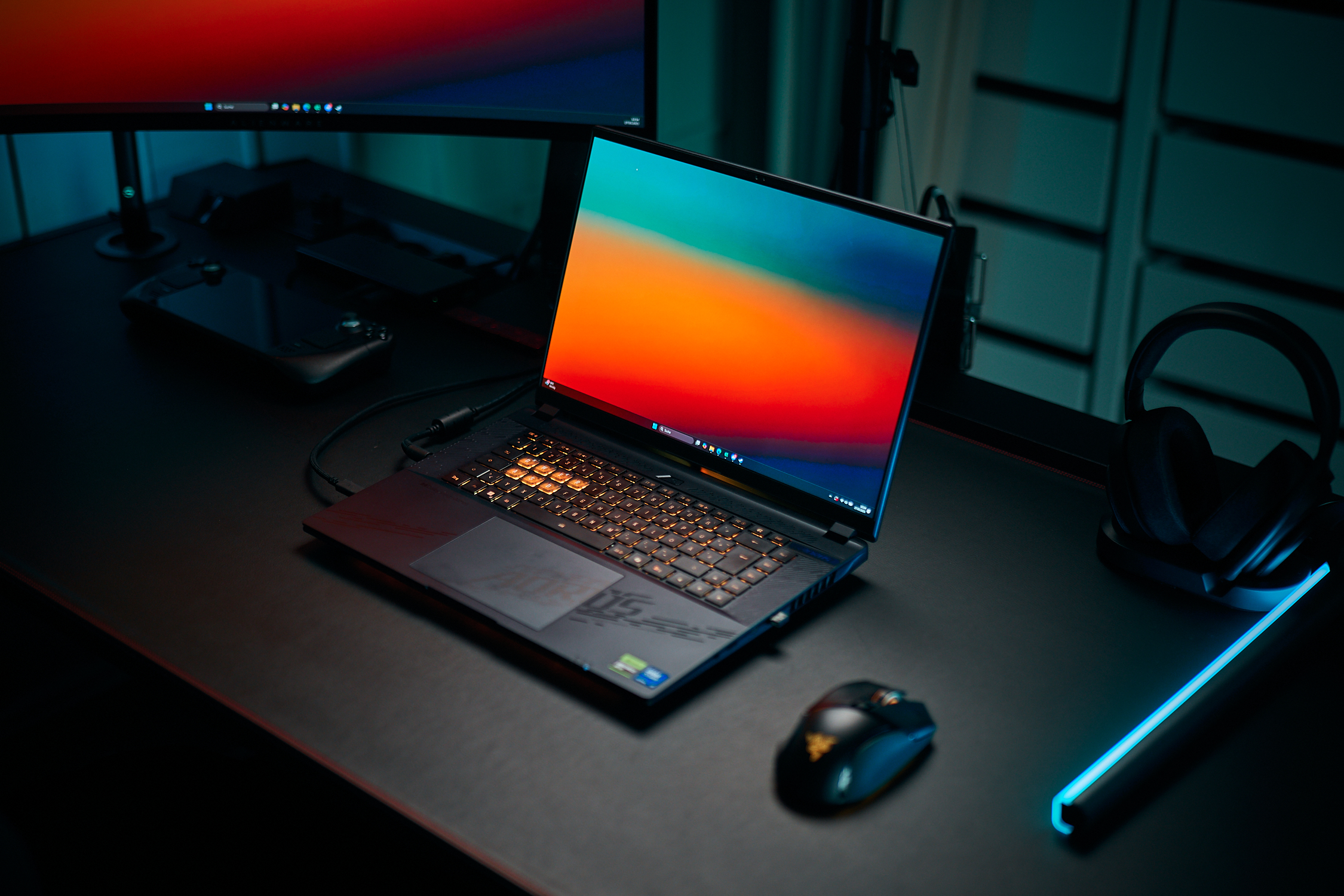
Competing against ROG, Legion and co with an RTX 5090 and 240 Hz OLED - Gigabyte Aorus Master 16 gaming laptop review
Who is the master, who is the disciple?
We finally managed to get our test-savvy hands on the Aorus Master 16 with an RTX 5090, OLED display, Thunderbolt 5, PCIe 5.0 and WiFi 7. Is this the new performance king for a price of $4,300?Christian Hintze, 👁 Christian Hintze (translated by Daisy Dickson) Published 🇩🇪 🇵🇹 ...
Verdict - A fast OLED gamer, but loud, expensive and not fully optimized
Thanks to its RTX 5090, the Aorus Master 16 is a super potent gaming laptop. It has modern connections such as Thunderbolt 5, supports Wi-Fi 7, and its fan control adjusts the speed according to the load, resulting in the gaming laptop staying very quiet under low load.
On the other hand, its fans reach an extremely loud volume of almost 60 dB under higher load. Although its performance is good despite these values, it doesn't break any records, with the XMG Neo 16 and the Lenovo Legion Pro 7i proving to be faster. Regular BIOS and GiMate updates have since fixed the initial hitches and lags. Overall, buyers get a very powerful OLED gaming laptop for a very high price, although there is still some room for improvement in terms of its build quality (keyword: left-click on the touchpad) and driver optimization.
Pros
Cons
Price and availability
You can buy the model with the RTX 5090 from Amazon, where it currently costs $4,299.99.
Table of Contents
- Verdict - A fast OLED gamer, but loud, expensive and not fully optimized
- Specifications - RTX 5090 & Core Ultra 9 275HX
- Case & connectivity - Lots of features, okay build
- Input devices - Not quite high-end
- Display - 1,600p OLED in the Master 16
- Performance - Very constant, but not the maximum
- Emissions & energy - Idle consumption still too high
- Notebookcheck total rating
- Possible alternatives compared
Aorus presented its new Master series at CES 2025 and we've finally had a chance to test it. The high-end model of the 16-inch laptop with the RTX 5090 promises a total TDP of up to 230 watts (55 + 175 watts), while the TDP of the 18-inch version that we recently tested even adds up to 270 watts.
Specifications - RTX 5090 & Core Ultra 9 275HX
Case & connectivity - Lots of features, okay build
Its case in the colorway "Dark Tide" (black) is made mostly of plastic, features an interesting structure on the bottom, has been spiced up with the Aorus design on the inside, and has been equipped with lighting elements on the outside, including a "logo projector" that projects the "Aorus" lettering onto a surface (e.g. a table) from the bottom center of the display. The laptop's general design is clearly based on the Aorus 16X.
However, the Master 16 is quite thick, measuring in at around 30 millimeters, but the Asus ROG Strix Scar 16 and the XMG Neo 16 E25 have similar dimensions and are even heavier. The Blade 16 and Zephyrus G16 are of course significantly thinner and lighter.
The device's case seems quite stable and hardly makes any noise when twisted. Its display bounces slightly, the hinges could be tighter and its maximum opening angle is around 130 degrees.
Its FHD webcam unfortunately takes rather unattractive photos with high color deviations and a hefty blue tint. Its transmission rates are quite high thanks to its Wi-Fi 7 support. The laptop's micro SD card reader works quite quickly. Fitted with one Thunderbolt 5 connection and one Thunderbolt 4 port, the Master 16 is otherwise well equipped. The position of its jack connector on the front right side isn't ideal.
| SD Card Reader | |
| average JPG Copy Test (av. of 3 runs) | |
| Asus ROG Zephyrus G16 GU605CX (Angelbird AV Pro V60) | |
| Razer Blade 16 2024, RTX 4090 | |
| Razer Blade 16 2025 RTX 5090 (Angelbird AV Pro V60) | |
| Average of class Gaming (20 - 210, n=66, last 2 years) | |
| Aorus MASTER 16 AM6H | |
| maximum AS SSD Seq Read Test (1GB) | |
| Asus ROG Zephyrus G16 GU605CX (Angelbird AV Pro V60) | |
| Aorus MASTER 16 AM6H | |
| Razer Blade 16 2025 RTX 5090 (Angelbird AV Pro V60) | |
| Razer Blade 16 2024, RTX 4090 | |
| Average of class Gaming (25.8 - 261, n=63, last 2 years) | |
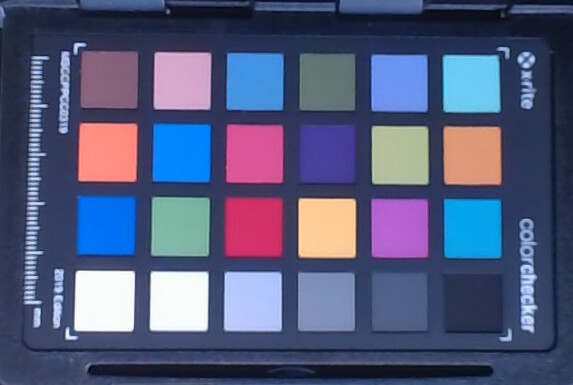
Maintenance
12 screws of three different lengths hold the base plate in place. But be careful—because of the LED lighting, the underside is still wired up to the top. On the inside, you can access the two M.2 NVMe SSDs (the replaceable WLAN module is located under one of them), RAM banks, screwed-in battery as well as the two fans.
Sustainability
Aorus hasn't provided any information on the laptop's CO2 footprint. Its packaging contains less than 5 percent plastic (box handle, laptop sleeve, dust cloth), while the rest is made of cardboard.
Input devices - Not quite high-end
The laptop's keys feel rather small for a 16-inch device, although the arrow keys are normal-sized and the QWERASD keys are highlighted. The lettering is a little too dark and the contrast on the dark keys is low. The lighting helps in this case, but then the contrast to the brightly labeled gaming keys is too low. The dedicated GiMate button, which is used to give instructions to the AI, is located on the right-hand side of the F-row, but doesn't work very well.
The keys' travel can be classed as short to medium and their feedback could be a tick sharper; it feels a little soft. The touch noises are moderate.
The laptop's touchpad is nice and big and very smooth in dry conditions. However, the integrated buttons have a very short pressure point; during our test, the left click got stuck several times.
Display - 1,600p OLED in the Master 16
Aorus has installed a reflective 1,600p OLED with a 240 Hz refresh rate, 100 percent DCI-P3 coverage, as well as HDR and G-Sync support.
We measured an average brightness of 437 nits in SDR mode when depicting 100% white, and its illumination is extremely even at 96%. In HDR mode during the APL 25 test, it even reached 635 nits. The panel flickers at a high 960 Hz, which shouldn't cause problems even for sensitive users.
Its contrast is of course excellent thanks to its extremely good black level, typical of OLED panels. Naturally, we didn't note any backlight bleeding—just pure black. The panel covers sRGB almost completely and even Display-P3 and AdobeRGB to around 95 percent.
| |||||||||||||||||||||||||
Brightness Distribution: 96 %
Center on Battery: 428 cd/m²
Contrast: 5438:1 (Black: 0.08 cd/m²)
ΔE ColorChecker Calman: 2.42 | ∀{0.5-29.43 Ø4.78}
calibrated: 2.03
ΔE Greyscale Calman: 3.11 | ∀{0.09-98 Ø5}
94.1% AdobeRGB 1998 (Argyll 3D)
98.8% sRGB (Argyll 3D)
95.3% Display P3 (Argyll 3D)
Gamma: 2.48
CCT: 6270 K
| Aorus MASTER 16 AM6H ATNA60DL03-0 (SDC41AB), OLED, 2560x1600, 16", 240 Hz | Asus ROG Zephyrus G16 GU605CX ATNA60DL01-0, OLED, 2560x1600, 16", 240 Hz | Razer Blade 16 2025 RTX 5090 ATNA60DL04-0, OLED, 2560x1600, 16", 240 Hz | Asus Strix Scar 18 G835LX N180QDM-NM2, Mini-LED, 2560x1600, 18", 240 Hz | Razer Blade 16 2024, RTX 4090 Samsung SDC41AB (ATNA60DL03-0), OLED, 2560x1600, 16", 240 Hz | |
|---|---|---|---|---|---|
| Display | 3% | -3% | -1% | 2% | |
| Display P3 Coverage (%) | 95.3 | 99.9 5% | 96.1 1% | 99 4% | 99.1 4% |
| sRGB Coverage (%) | 98.8 | 100 1% | 99.9 1% | 100 1% | 99.9 1% |
| AdobeRGB 1998 Coverage (%) | 94.1 | 96.9 3% | 85 -10% | 87.2 -7% | 95.6 2% |
| Response Times | 25% | 22% | -1805% | 4% | |
| Response Time Grey 50% / Grey 80% * (ms) | 0.24 ? | 0.22 8% | 0.2 ? 17% | 7.4 ? -2983% | 0.24 ? -0% |
| Response Time Black / White * (ms) | 0.43 ? | 0.25 42% | 0.25 ? 42% | 10.4 ? -2319% | 0.4 ? 7% |
| PWM Frequency (Hz) | 960 | 960 | 960 ? | 20610 ? | 960 |
| PWM Amplitude * (%) | 47 | 44 6% | 100 -113% | ||
| Screen | 16% | 18% | 38% | 60% | |
| Brightness middle (cd/m²) | 435 | 416 -4% | 391 -10% | 764 76% | 418 -4% |
| Brightness (cd/m²) | 437 | 418 -4% | 393 -10% | 747 71% | 420 -4% |
| Brightness Distribution (%) | 96 | 96 0% | 98 2% | 93 -3% | 98 2% |
| Black Level * (cd/m²) | 0.08 | 0.1 -25% | 0.02 75% | ||
| Contrast (:1) | 5438 | 7640 40% | 20900 284% | ||
| Colorchecker dE 2000 * | 2.42 | 1.6 34% | 1.2 50% | 1.2 50% | 1.07 56% |
| Colorchecker dE 2000 max. * | 4.81 | 2.1 56% | 3.2 33% | 2.8 42% | 4.04 16% |
| Colorchecker dE 2000 calibrated * | 2.03 | 1.07 47% | |||
| Greyscale dE 2000 * | 3.11 | 2.7 13% | 1.8 42% | 1.5 52% | 1.12 64% |
| Gamma | 2.48 89% | 2.16 102% | 2.2 100% | 2.17 101% | 2.29 96% |
| CCT | 6270 104% | 6331 103% | 6493 100% | 6556 99% | 6417 101% |
| Total Average (Program / Settings) | 15% /
14% | 12% /
14% | -589% /
-365% | 22% /
39% |
* ... smaller is better
The panel is properly calibrated straight out of the box, but not against its maximum brightness. Its DeltaE values were slightly too high in this case. Our manual calibration using X-Rite i1 Pro 3 and the Calman software (against the P3 color space) reduced the deviations slightly, especially in the grayscale.
Display Response Times
| ↔ Response Time Black to White | ||
|---|---|---|
| 0.43 ms ... rise ↗ and fall ↘ combined | ↗ 0.18 ms rise | |
| ↘ 0.25 ms fall | ||
| The screen shows very fast response rates in our tests and should be very well suited for fast-paced gaming. In comparison, all tested devices range from 0.1 (minimum) to 240 (maximum) ms. » 0 % of all devices are better. This means that the measured response time is better than the average of all tested devices (20.2 ms). | ||
| ↔ Response Time 50% Grey to 80% Grey | ||
| 0.24 ms ... rise ↗ and fall ↘ combined | ↗ 0.12 ms rise | |
| ↘ 0.12 ms fall | ||
| The screen shows very fast response rates in our tests and should be very well suited for fast-paced gaming. In comparison, all tested devices range from 0.165 (minimum) to 636 (maximum) ms. » 0 % of all devices are better. This means that the measured response time is better than the average of all tested devices (31.6 ms). | ||
Screen Flickering / PWM (Pulse-Width Modulation)
| Screen flickering / PWM detected | 960 Hz Amplitude: 47 % | ||
The display backlight flickers at 960 Hz (worst case, e.g., utilizing PWM) . The frequency of 960 Hz is quite high, so most users sensitive to PWM should not notice any flickering. In comparison: 53 % of all tested devices do not use PWM to dim the display. If PWM was detected, an average of 8105 (minimum: 5 - maximum: 343500) Hz was measured. | |||
Performance - Very constant, but not the maximum
The Master 16 is a true gaming laptop, and not just visually (LED strips). The three model variants only differ in terms of their GPU configuration. Our top-of-the-range model is equipped with an RTX 5090, while the RTX 5080 and RTX 5070 Ti are further options.
Testing conditions
GiMate serves as the laptop's control center. The home screen is nice and clear thanks to its simple structure, but this is somewhat lost in other menu sections. GiMate could also do with being optimized, it takes quite a long time to load and the CPU load could be reduced somewhat.
In general, there seem to be a few problems with the laptop's graphics switching. For example, when pulling the plug, we were asked whether we wanted to switch off the dGPU to save energy, but even if we said no, the dGPU was no longer active. In GiMate, we then discovered quite hidden in the Scenario - Power Supply - AI Power Gear II menu that even in Gaming mode, the dGPU is deactivated by default as soon as battery mode is active. We changed the mode to Optimus and set it to maximum performance for the profile Gaming. Only then did more demanding 3D applications also work properly in battery mode.
The fact that it's virtually impossible to play in Gaming mode by default (away from a power outlet) is a strange decision by the developers. In addition, it sometimes takes half a minute for the laptop to recognize that we have plugged the power adapter back in.
During our test, updates for the BIOS and GiMate were released regularly, which significantly improved these problems (e.g. power plug problem, lags). The installation was very straightforward via the live updates in GiMate.
We selected Gaming mode for our benchmarks and the AI boost was active.
Processor
At its heart is the Intel Core Ultra 9 275HX with a full 24 cores and a 2.1 to 5.4 GHz clock. This is a high-end laptop CPU that integrates a small dedicated NPU called AI Boost with 13 TOPS and a small Intel Graphics with 4 cores.
The CPU performed in line with our expectations across all tests, but the same CPU was faster in the Asus Strix Scar 18, as was the Neo 16 with an AMD processor—while the thinner Blade 16 and Zephyrus G16 were slower.
Our Cinebench R15 endurance test (Multi) revealed a very consistent performance. The laptop's maximum power consumption was 140 watts.
In battery mode, the latter only came to approx. 39 watts, its performance loss was approx. 50 percent, similar to Energy-Saving mode.
Cinebench R15 Multi continuous test
Cinebench R23: Multi Core | Single Core
Cinebench R20: CPU (Multi Core) | CPU (Single Core)
Cinebench R15: CPU Multi 64Bit | CPU Single 64Bit
Blender: v2.79 BMW27 CPU
7-Zip 18.03: 7z b 4 | 7z b 4 -mmt1
Geekbench 6.5: Multi-Core | Single-Core
Geekbench 5.5: Multi-Core | Single-Core
HWBOT x265 Benchmark v2.2: 4k Preset
LibreOffice : 20 Documents To PDF
R Benchmark 2.5: Overall mean
| CPU Performance rating | |
| Asus Strix Scar 18 G835LX | |
| Schenker Neo 16 A25 5090 Engineering Sample | |
| Average Intel Core Ultra 9 275HX | |
| Aorus MASTER 16 AM6H | |
| Razer Blade 16 2024, RTX 4090 | |
| Razer Blade 16 2025 RTX 5090 | |
| Average of class Gaming | |
| Asus ROG Zephyrus G16 GU605CX | |
| Cinebench R23 / Multi Core | |
| Schenker Neo 16 A25 5090 Engineering Sample | |
| Asus Strix Scar 18 G835LX | |
| Aorus MASTER 16 AM6H | |
| Average Intel Core Ultra 9 275HX (30712 - 40970, n=28) | |
| Razer Blade 16 2024, RTX 4090 | |
| Average of class Gaming (5668 - 40970, n=145, last 2 years) | |
| Razer Blade 16 2025 RTX 5090 | |
| Asus ROG Zephyrus G16 GU605CX | |
| Cinebench R23 / Single Core | |
| Asus Strix Scar 18 G835LX | |
| Aorus MASTER 16 AM6H | |
| Average Intel Core Ultra 9 275HX (2009 - 2267, n=28) | |
| Schenker Neo 16 A25 5090 Engineering Sample | |
| Asus ROG Zephyrus G16 GU605CX | |
| Razer Blade 16 2024, RTX 4090 | |
| Razer Blade 16 2025 RTX 5090 | |
| Average of class Gaming (1136 - 2267, n=145, last 2 years) | |
| Cinebench R20 / CPU (Multi Core) | |
| Asus Strix Scar 18 G835LX | |
| Schenker Neo 16 A25 5090 Engineering Sample | |
| Aorus MASTER 16 AM6H | |
| Average Intel Core Ultra 9 275HX (12026 - 16108, n=27) | |
| Razer Blade 16 2024, RTX 4090 | |
| Average of class Gaming (2179 - 16108, n=144, last 2 years) | |
| Razer Blade 16 2025 RTX 5090 | |
| Asus ROG Zephyrus G16 GU605CX | |
| Cinebench R20 / CPU (Single Core) | |
| Asus Strix Scar 18 G835LX | |
| Aorus MASTER 16 AM6H | |
| Schenker Neo 16 A25 5090 Engineering Sample | |
| Average Intel Core Ultra 9 275HX (774 - 870, n=27) | |
| Asus ROG Zephyrus G16 GU605CX | |
| Razer Blade 16 2024, RTX 4090 | |
| Razer Blade 16 2025 RTX 5090 | |
| Average of class Gaming (439 - 870, n=144, last 2 years) | |
| Cinebench R15 / CPU Multi 64Bit | |
| Schenker Neo 16 A25 5090 Engineering Sample | |
| Asus Strix Scar 18 G835LX | |
| Aorus MASTER 16 AM6H | |
| Average Intel Core Ultra 9 275HX (4756 - 6271, n=27) | |
| Razer Blade 16 2024, RTX 4090 | |
| Average of class Gaming (1537 - 6271, n=144, last 2 years) | |
| Razer Blade 16 2025 RTX 5090 | |
| Asus ROG Zephyrus G16 GU605CX | |
| Cinebench R15 / CPU Single 64Bit | |
| Asus Strix Scar 18 G835LX | |
| Schenker Neo 16 A25 5090 Engineering Sample | |
| Aorus MASTER 16 AM6H | |
| Average Intel Core Ultra 9 275HX (306 - 343, n=28) | |
| Asus ROG Zephyrus G16 GU605CX | |
| Razer Blade 16 2024, RTX 4090 | |
| Razer Blade 16 2025 RTX 5090 | |
| Average of class Gaming (188.8 - 343, n=143, last 2 years) | |
| Blender / v2.79 BMW27 CPU | |
| Asus ROG Zephyrus G16 GU605CX | |
| Average of class Gaming (80 - 517, n=140, last 2 years) | |
| Razer Blade 16 2025 RTX 5090 | |
| Razer Blade 16 2024, RTX 4090 | |
| Average Intel Core Ultra 9 275HX (82 - 116, n=26) | |
| Aorus MASTER 16 AM6H | |
| Asus Strix Scar 18 G835LX | |
| Schenker Neo 16 A25 5090 Engineering Sample | |
| 7-Zip 18.03 / 7z b 4 | |
| Schenker Neo 16 A25 5090 Engineering Sample | |
| Asus Strix Scar 18 G835LX | |
| Razer Blade 16 2024, RTX 4090 | |
| Average Intel Core Ultra 9 275HX (98236 - 124155, n=27) | |
| Aorus MASTER 16 AM6H | |
| Average of class Gaming (23795 - 148086, n=142, last 2 years) | |
| Razer Blade 16 2025 RTX 5090 | |
| Asus ROG Zephyrus G16 GU605CX | |
| 7-Zip 18.03 / 7z b 4 -mmt1 | |
| Schenker Neo 16 A25 5090 Engineering Sample | |
| Asus Strix Scar 18 G835LX | |
| Razer Blade 16 2024, RTX 4090 | |
| Average Intel Core Ultra 9 275HX (6026 - 7149, n=27) | |
| Aorus MASTER 16 AM6H | |
| Average of class Gaming (4199 - 7508, n=142, last 2 years) | |
| Razer Blade 16 2025 RTX 5090 | |
| Asus ROG Zephyrus G16 GU605CX | |
| Geekbench 6.5 / Multi-Core | |
| Asus Strix Scar 18 G835LX | |
| Schenker Neo 16 A25 5090 Engineering Sample | |
| Average Intel Core Ultra 9 275HX (16033 - 21668, n=29) | |
| Aorus MASTER 16 AM6H | |
| Razer Blade 16 2024, RTX 4090 | |
| Asus ROG Zephyrus G16 GU605CX | |
| Razer Blade 16 2025 RTX 5090 | |
| Average of class Gaming (5340 - 22104, n=142, last 2 years) | |
| Geekbench 6.5 / Single-Core | |
| Schenker Neo 16 A25 5090 Engineering Sample | |
| Asus Strix Scar 18 G835LX | |
| Aorus MASTER 16 AM6H | |
| Average Intel Core Ultra 9 275HX (2843 - 3160, n=29) | |
| Razer Blade 16 2024, RTX 4090 | |
| Razer Blade 16 2025 RTX 5090 | |
| Asus ROG Zephyrus G16 GU605CX | |
| Average of class Gaming (1490 - 3253, n=142, last 2 years) | |
| Geekbench 5.5 / Multi-Core | |
| Asus Strix Scar 18 G835LX | |
| Average Intel Core Ultra 9 275HX (19105 - 25855, n=28) | |
| Aorus MASTER 16 AM6H | |
| Schenker Neo 16 A25 5090 Engineering Sample | |
| Razer Blade 16 2024, RTX 4090 | |
| Average of class Gaming (4557 - 27010, n=141, last 2 years) | |
| Asus ROG Zephyrus G16 GU605CX | |
| Razer Blade 16 2025 RTX 5090 | |
| Geekbench 5.5 / Single-Core | |
| Schenker Neo 16 A25 5090 Engineering Sample | |
| Asus Strix Scar 18 G835LX | |
| Aorus MASTER 16 AM6H | |
| Average Intel Core Ultra 9 275HX (2033 - 2292, n=28) | |
| Razer Blade 16 2025 RTX 5090 | |
| Razer Blade 16 2024, RTX 4090 | |
| Asus ROG Zephyrus G16 GU605CX | |
| Average of class Gaming (986 - 2423, n=141, last 2 years) | |
| HWBOT x265 Benchmark v2.2 / 4k Preset | |
| Schenker Neo 16 A25 5090 Engineering Sample | |
| Asus Strix Scar 18 G835LX | |
| Average Intel Core Ultra 9 275HX (30.7 - 43.8, n=27) | |
| Aorus MASTER 16 AM6H | |
| Razer Blade 16 2024, RTX 4090 | |
| Razer Blade 16 2025 RTX 5090 | |
| Average of class Gaming (7.7 - 44.3, n=142, last 2 years) | |
| Asus ROG Zephyrus G16 GU605CX | |
| LibreOffice / 20 Documents To PDF | |
| Schenker Neo 16 A25 5090 Engineering Sample | |
| Average of class Gaming (19 - 88.8, n=141, last 2 years) | |
| Razer Blade 16 2024, RTX 4090 | |
| Razer Blade 16 2025 RTX 5090 | |
| Asus ROG Zephyrus G16 GU605CX | |
| Average Intel Core Ultra 9 275HX (33.2 - 62.1, n=27) | |
| Asus Strix Scar 18 G835LX | |
| Aorus MASTER 16 AM6H | |
| R Benchmark 2.5 / Overall mean | |
| Asus ROG Zephyrus G16 GU605CX | |
| Aorus MASTER 16 AM6H | |
| Average of class Gaming (0.3551 - 0.759, n=143, last 2 years) | |
| Average Intel Core Ultra 9 275HX (0.3943 - 0.4568, n=27) | |
| Razer Blade 16 2025 RTX 5090 | |
| Asus Strix Scar 18 G835LX | |
| Razer Blade 16 2024, RTX 4090 | |
| Schenker Neo 16 A25 5090 Engineering Sample | |
* ... smaller is better
AIDA64: FP32 Ray-Trace | FPU Julia | CPU SHA3 | CPU Queen | FPU SinJulia | FPU Mandel | CPU AES | CPU ZLib | FP64 Ray-Trace | CPU PhotoWorxx
| Performance rating | |
| Schenker Neo 16 A25 5090 Engineering Sample | |
| Asus Strix Scar 18 G835LX | |
| Aorus MASTER 16 AM6H | |
| Average Intel Core Ultra 9 275HX | |
| Razer Blade 16 2024, RTX 4090 | |
| Razer Blade 16 2025 RTX 5090 | |
| Average of class Gaming | |
| Asus ROG Zephyrus G16 GU605CX | |
| AIDA64 / FP32 Ray-Trace | |
| Schenker Neo 16 A25 5090 Engineering Sample | |
| Asus Strix Scar 18 G835LX | |
| Aorus MASTER 16 AM6H | |
| Razer Blade 16 2025 RTX 5090 | |
| Average Intel Core Ultra 9 275HX (28067 - 39895, n=27) | |
| Average of class Gaming (7192 - 85542, n=141, last 2 years) | |
| Razer Blade 16 2024, RTX 4090 | |
| Asus ROG Zephyrus G16 GU605CX | |
| AIDA64 / FPU Julia | |
| Schenker Neo 16 A25 5090 Engineering Sample | |
| Asus Strix Scar 18 G835LX | |
| Aorus MASTER 16 AM6H | |
| Average Intel Core Ultra 9 275HX (140254 - 200744, n=27) | |
| Razer Blade 16 2025 RTX 5090 | |
| Razer Blade 16 2024, RTX 4090 | |
| Average of class Gaming (35040 - 238426, n=141, last 2 years) | |
| Asus ROG Zephyrus G16 GU605CX | |
| AIDA64 / CPU SHA3 | |
| Schenker Neo 16 A25 5090 Engineering Sample | |
| Asus Strix Scar 18 G835LX | |
| Aorus MASTER 16 AM6H | |
| Average Intel Core Ultra 9 275HX (6766 - 9817, n=27) | |
| Razer Blade 16 2024, RTX 4090 | |
| Average of class Gaming (1728 - 9817, n=141, last 2 years) | |
| Razer Blade 16 2025 RTX 5090 | |
| Asus ROG Zephyrus G16 GU605CX | |
| AIDA64 / CPU Queen | |
| Schenker Neo 16 A25 5090 Engineering Sample | |
| Asus Strix Scar 18 G835LX | |
| Razer Blade 16 2024, RTX 4090 | |
| Aorus MASTER 16 AM6H | |
| Average Intel Core Ultra 9 275HX (113887 - 140937, n=27) | |
| Average of class Gaming (50699 - 173351, n=141, last 2 years) | |
| Razer Blade 16 2025 RTX 5090 | |
| Asus ROG Zephyrus G16 GU605CX | |
| AIDA64 / FPU SinJulia | |
| Schenker Neo 16 A25 5090 Engineering Sample | |
| Razer Blade 16 2025 RTX 5090 | |
| Razer Blade 16 2024, RTX 4090 | |
| Average of class Gaming (5020 - 33636, n=141, last 2 years) | |
| Asus Strix Scar 18 G835LX | |
| Aorus MASTER 16 AM6H | |
| Average Intel Core Ultra 9 275HX (11172 - 14425, n=27) | |
| Asus ROG Zephyrus G16 GU605CX | |
| AIDA64 / FPU Mandel | |
| Schenker Neo 16 A25 5090 Engineering Sample | |
| Asus Strix Scar 18 G835LX | |
| Aorus MASTER 16 AM6H | |
| Average Intel Core Ultra 9 275HX (72596 - 104508, n=27) | |
| Razer Blade 16 2025 RTX 5090 | |
| Average of class Gaming (17585 - 128721, n=141, last 2 years) | |
| Razer Blade 16 2024, RTX 4090 | |
| Asus ROG Zephyrus G16 GU605CX | |
| AIDA64 / CPU AES | |
| Schenker Neo 16 A25 5090 Engineering Sample | |
| Asus Strix Scar 18 G835LX | |
| Average Intel Core Ultra 9 275HX (107195 - 247074, n=27) | |
| Aorus MASTER 16 AM6H | |
| Razer Blade 16 2024, RTX 4090 | |
| Average of class Gaming (19065 - 247074, n=141, last 2 years) | |
| Razer Blade 16 2025 RTX 5090 | |
| Asus ROG Zephyrus G16 GU605CX | |
| AIDA64 / CPU ZLib | |
| Schenker Neo 16 A25 5090 Engineering Sample | |
| Asus Strix Scar 18 G835LX | |
| Aorus MASTER 16 AM6H | |
| Average Intel Core Ultra 9 275HX (1599 - 2263, n=27) | |
| Razer Blade 16 2024, RTX 4090 | |
| Average of class Gaming (373 - 2531, n=141, last 2 years) | |
| Razer Blade 16 2025 RTX 5090 | |
| Asus ROG Zephyrus G16 GU605CX | |
| AIDA64 / FP64 Ray-Trace | |
| Schenker Neo 16 A25 5090 Engineering Sample | |
| Asus Strix Scar 18 G835LX | |
| Aorus MASTER 16 AM6H | |
| Razer Blade 16 2025 RTX 5090 | |
| Average Intel Core Ultra 9 275HX (14847 - 21854, n=27) | |
| Average of class Gaming (3856 - 45446, n=141, last 2 years) | |
| Razer Blade 16 2024, RTX 4090 | |
| Asus ROG Zephyrus G16 GU605CX | |
| AIDA64 / CPU PhotoWorxx | |
| Asus ROG Zephyrus G16 GU605CX | |
| Asus Strix Scar 18 G835LX | |
| Razer Blade 16 2025 RTX 5090 | |
| Average Intel Core Ultra 9 275HX (37482 - 62916, n=27) | |
| Razer Blade 16 2024, RTX 4090 | |
| Aorus MASTER 16 AM6H | |
| Average of class Gaming (10805 - 62916, n=141, last 2 years) | |
| Schenker Neo 16 A25 5090 Engineering Sample | |
System performance
In PCMark 10, our Master performed somewhat below average for its installed hardware, but it was able to make up for this small disadvantage in CrossMark.
Still, the system doesn't always feel completely smooth. Thankfully, however, lots of issues (lagging gifs, briefly freezing windows, etc.) have at least been fixed by the BIOS and GiMate updates.
CrossMark: Overall | Productivity | Creativity | Responsiveness
WebXPRT 3: Overall
WebXPRT 4: Overall
Mozilla Kraken 1.1: Total
| PCMark 10 / Score | |
| Schenker Neo 16 A25 5090 Engineering Sample | |
| Asus ROG Zephyrus G16 GU605CX | |
| Asus Strix Scar 18 G835LX | |
| Average Intel Core Ultra 9 275HX, NVIDIA GeForce RTX 5090 Laptop (7474 - 9497, n=11) | |
| Razer Blade 16 2024, RTX 4090 | |
| Razer Blade 16 2025 RTX 5090 | |
| Aorus MASTER 16 AM6H | |
| Average of class Gaming (5776 - 9647, n=120, last 2 years) | |
| PCMark 10 / Essentials | |
| Schenker Neo 16 A25 5090 Engineering Sample | |
| Asus Strix Scar 18 G835LX | |
| Average Intel Core Ultra 9 275HX, NVIDIA GeForce RTX 5090 Laptop (9994 - 11369, n=12) | |
| Razer Blade 16 2024, RTX 4090 | |
| Average of class Gaming (8840 - 12600, n=124, last 2 years) | |
| Asus ROG Zephyrus G16 GU605CX | |
| Razer Blade 16 2025 RTX 5090 | |
| Aorus MASTER 16 AM6H | |
| PCMark 10 / Productivity | |
| Asus ROG Zephyrus G16 GU605CX | |
| Razer Blade 16 2024, RTX 4090 | |
| Schenker Neo 16 A25 5090 Engineering Sample | |
| Razer Blade 16 2025 RTX 5090 | |
| Average of class Gaming (6662 - 14612, n=120, last 2 years) | |
| Average Intel Core Ultra 9 275HX, NVIDIA GeForce RTX 5090 Laptop (9122 - 10925, n=11) | |
| Asus Strix Scar 18 G835LX | |
| Aorus MASTER 16 AM6H | |
| PCMark 10 / Digital Content Creation | |
| Schenker Neo 16 A25 5090 Engineering Sample | |
| Asus Strix Scar 18 G835LX | |
| Average Intel Core Ultra 9 275HX, NVIDIA GeForce RTX 5090 Laptop (9952 - 19234, n=11) | |
| Aorus MASTER 16 AM6H | |
| Asus ROG Zephyrus G16 GU605CX | |
| Razer Blade 16 2025 RTX 5090 | |
| Average of class Gaming (7440 - 19351, n=120, last 2 years) | |
| Razer Blade 16 2024, RTX 4090 | |
| CrossMark / Overall | |
| Schenker Neo 16 A25 5090 Engineering Sample | |
| Aorus MASTER 16 AM6H | |
| Asus Strix Scar 18 G835LX | |
| Average Intel Core Ultra 9 275HX, NVIDIA GeForce RTX 5090 Laptop (1995 - 2339, n=12) | |
| Razer Blade 16 2024, RTX 4090 | |
| Asus ROG Zephyrus G16 GU605CX | |
| Average of class Gaming (1247 - 2344, n=115, last 2 years) | |
| CrossMark / Productivity | |
| Aorus MASTER 16 AM6H | |
| Average Intel Core Ultra 9 275HX, NVIDIA GeForce RTX 5090 Laptop (1847 - 2211, n=12) | |
| Asus Strix Scar 18 G835LX | |
| Schenker Neo 16 A25 5090 Engineering Sample | |
| Razer Blade 16 2024, RTX 4090 | |
| Asus ROG Zephyrus G16 GU605CX | |
| Average of class Gaming (1299 - 2211, n=115, last 2 years) | |
| CrossMark / Creativity | |
| Schenker Neo 16 A25 5090 Engineering Sample | |
| Asus Strix Scar 18 G835LX | |
| Average Intel Core Ultra 9 275HX, NVIDIA GeForce RTX 5090 Laptop (2170 - 2642, n=12) | |
| Aorus MASTER 16 AM6H | |
| Razer Blade 16 2024, RTX 4090 | |
| Asus ROG Zephyrus G16 GU605CX | |
| Average of class Gaming (1275 - 2729, n=115, last 2 years) | |
| CrossMark / Responsiveness | |
| Aorus MASTER 16 AM6H | |
| Schenker Neo 16 A25 5090 Engineering Sample | |
| Average Intel Core Ultra 9 275HX, NVIDIA GeForce RTX 5090 Laptop (1673 - 2217, n=12) | |
| Razer Blade 16 2024, RTX 4090 | |
| Asus Strix Scar 18 G835LX | |
| Average of class Gaming (1030 - 2330, n=115, last 2 years) | |
| Asus ROG Zephyrus G16 GU605CX | |
| WebXPRT 3 / Overall | |
| Average Intel Core Ultra 9 275HX, NVIDIA GeForce RTX 5090 Laptop (315 - 372, n=12) | |
| Asus Strix Scar 18 G835LX | |
| Aorus MASTER 16 AM6H | |
| Asus ROG Zephyrus G16 GU605CX | |
| Razer Blade 16 2024, RTX 4090 | |
| Schenker Neo 16 A25 5090 Engineering Sample | |
| Razer Blade 16 2025 RTX 5090 | |
| Average of class Gaming (237 - 532, n=120, last 2 years) | |
| WebXPRT 4 / Overall | |
| Asus Strix Scar 18 G835LX | |
| Aorus MASTER 16 AM6H | |
| Average Intel Core Ultra 9 275HX, NVIDIA GeForce RTX 5090 Laptop (301 - 341, n=11) | |
| Asus ROG Zephyrus G16 GU605CX | |
| Schenker Neo 16 A25 5090 Engineering Sample | |
| Average of class Gaming (176.4 - 345, n=115, last 2 years) | |
| Razer Blade 16 2025 RTX 5090 | |
| Mozilla Kraken 1.1 / Total | |
| Average of class Gaming (397 - 674, n=129, last 2 years) | |
| Razer Blade 16 2024, RTX 4090 | |
| Asus ROG Zephyrus G16 GU605CX | |
| Razer Blade 16 2025 RTX 5090 | |
| Average Intel Core Ultra 9 275HX, NVIDIA GeForce RTX 5090 Laptop (402 - 424, n=12) | |
| Aorus MASTER 16 AM6H | |
| Asus Strix Scar 18 G835LX | |
| Schenker Neo 16 A25 5090 Engineering Sample | |
* ... smaller is better
| PCMark 10 Score | 8241 points | |
Help | ||
| AIDA64 / Memory Copy | |
| Asus ROG Zephyrus G16 GU605CX | |
| Razer Blade 16 2025 RTX 5090 | |
| Asus Strix Scar 18 G835LX | |
| Average Intel Core Ultra 9 275HX (56003 - 94460, n=27) | |
| Razer Blade 16 2024, RTX 4090 | |
| Aorus MASTER 16 AM6H | |
| Average of class Gaming (21750 - 104987, n=141, last 2 years) | |
| Schenker Neo 16 A25 5090 Engineering Sample | |
| AIDA64 / Memory Read | |
| Razer Blade 16 2025 RTX 5090 | |
| Razer Blade 16 2024, RTX 4090 | |
| Asus Strix Scar 18 G835LX | |
| Average Intel Core Ultra 9 275HX (55795 - 97151, n=27) | |
| Aorus MASTER 16 AM6H | |
| Asus ROG Zephyrus G16 GU605CX | |
| Average of class Gaming (22956 - 104349, n=141, last 2 years) | |
| Schenker Neo 16 A25 5090 Engineering Sample | |
| AIDA64 / Memory Write | |
| Razer Blade 16 2025 RTX 5090 | |
| Asus Strix Scar 18 G835LX | |
| Average Intel Core Ultra 9 275HX (55663 - 106063, n=27) | |
| Razer Blade 16 2024, RTX 4090 | |
| Asus ROG Zephyrus G16 GU605CX | |
| Aorus MASTER 16 AM6H | |
| Average of class Gaming (22297 - 133486, n=141, last 2 years) | |
| Schenker Neo 16 A25 5090 Engineering Sample | |
| AIDA64 / Memory Latency | |
| Asus ROG Zephyrus G16 GU605CX | |
| Average Intel Core Ultra 9 275HX (105.8 - 161.6, n=27) | |
| Aorus MASTER 16 AM6H | |
| Asus Strix Scar 18 G835LX | |
| Razer Blade 16 2025 RTX 5090 | |
| Schenker Neo 16 A25 5090 Engineering Sample | |
| Average of class Gaming (59.5 - 259, n=141, last 2 years) | |
| Razer Blade 16 2024, RTX 4090 | |
* ... smaller is better
DPC latencies
During our test, the first delays occured as soon as we launched LatencyMon. These increased when launching the browser, as well as when opening several tabs. There were also delays and 10 dropped frames when playing our 4K/60 fps YouTube video. The iGPU was running at almost 50 percent capacity.
| DPC Latencies / LatencyMon - interrupt to process latency (max), Web, Youtube, Prime95 | |
| Asus ROG Zephyrus G16 GU605CX | |
| Aorus MASTER 16 AM6H | |
| Razer Blade 16 2024, RTX 4090 | |
| Asus Strix Scar 18 G835LX | |
| Razer Blade 16 2025 RTX 5090 | |
* ... smaller is better
Storage device
Aorus has installed two Kingston NVMe SSDs with 1 TB of storage each, so there is plenty of space for games and apps. In our performance comparison, the storage ranked in the middle of the competition—only the SSD in the Schenker Neo 16 was significantly faster. Its continuous performance in the Aorus was very consistent.
* ... smaller is better
Reading continuous performance: DiskSpd Read Loop, Queue Depth 8
GPU performance
The new RTX 5090 is the current Nvidia flagship and, of course, is the main reason for this laptop's high price.
During the synthetic 3DMarks, the Master 16 was "only" on par with the Razer Blade 16 in Gaming mode, while it clearly beat the Zephyrus G16. Overall, we noted a performance at the level we expected.
When running games, our Aorus Master 16 outperformed the Blade and Zephyrus by around 20 percentage points. However, there seemed to be no way around the XMG Neo 16 when it came to taking the performance crown. Gaming proved to be particularly fun when, for example, we almost exhausted the OLED's native refresh rate of 240 Hz when running Doom: The Dark Ages with DLSS 4 and quadruple Frame Generation in QHD. The slightly higher latency was virtually unnoticeable in QHD.
In Balanced mode, only a few frames were lost during Cyberpunk 2077; in the Energy-Saving profile with quiet fans, its performance dropped by around 20 percent, which was still completely sufficient for most games and easy on the ears.
When we pulled the plug, 3D applications only ran after the above-mentioned option was changed. A new Fire Strike run revealed a 3D performance loss of approx. 41 percent.
| 3DMark 11 Performance | 49578 points | |
| 3DMark Cloud Gate Standard Score | 69384 points | |
| 3DMark Fire Strike Score | 36506 points | |
| 3DMark Time Spy Score | 22835 points | |
| 3DMark Steel Nomad Score | 5828 points | |
Help | ||
* ... smaller is better
| GTA V - 1920x1080 Highest AA:4xMSAA + FX AF:16x | |
| Asus ROG Strix G16 G615 | |
| Schenker XMG Neo 16 E25 RTX 5090 Laptop | |
| Asus ROG Strix Scar 16 2025 | |
| Aorus MASTER 16 AM6H | |
| Average of class Gaming (12.1 - 186.9, n=128, last 2 years) | |
| Razer Blade 16 2025 RTX 5090 | |
| The Witcher 3 - 1920x1080 Ultra Graphics & Postprocessing (HBAO+) | |
| Aorus MASTER 16 AM6H | |
| Average NVIDIA GeForce RTX 5090 Laptop (192 - 240, n=4) | |
| Razer Blade 16 2025 RTX 5090 | |
| Average of class Gaming (18.4 - 240, n=55, last 2 years) | |
Cyberpunk 2077 ultra FPS diagram
| low | med. | high | ultra | QHD DLSS | QHD | 4K DLSS | 4K | |
|---|---|---|---|---|---|---|---|---|
| GTA V (2015) | 182 | 178 | 180.5 | 140.9 | 96.9 | 173.2 | ||
| The Witcher 3 (2015) | 224 | 185 | 114 | |||||
| Dota 2 Reborn (2015) | 216 | 189.4 | 179.2 | 166.4 | 168.6 | |||
| Final Fantasy XV Benchmark (2018) | 233 | 232 | 201 | 160.5 | 103.9 | |||
| X-Plane 11.11 (2018) | 161.3 | 143.9 | 113.2 | 104.3 | ||||
| Strange Brigade (2018) | 511 | 426 | 425 | 408 | 287 | 177.5 | ||
| Baldur's Gate 3 (2023) | 250 | 199 | 197 | 194 | 192 | 151 | 129 | 85.3 |
| Cyberpunk 2077 (2023) | 154.7 | 154.5 | 147 | 137.5 | 118.4 | 109.7 | 76.9 | 52.7 |
| Alan Wake 2 (2023) | 95 | 81.1 | 43.1 | |||||
| F1 24 (2024) | 240 | 260 | 252 | 129 | 126 | 90 | 82 | 50 |
| Black Myth: Wukong (2024) | 74 | 67 | 47 | 28 | ||||
| Indiana Jones and the Great Circle (2024) | 132 | 118 | 102 | 66.6 | ||||
| Monster Hunter Wilds (2025) | 80.82 | 78.96 | 70.26 | 61.19 | 46 | |||
| Assassin's Creed Shadows (2025) | 63 | 65 | 56 | 53 | 40 | |||
| Doom: The Dark Ages (2025) | 133.5 | 117.3 | 108.4 | 105.3 | 102.3 | 77 | 63 | 43.3 |
Emissions & energy - Idle consumption still too high
Noise emissions
When idling, the laptop's fans are mostly off and even after a period of load, they quickly calm down again in stages—very good! Under high load such as when gaming, the fan speeds increase continuously. Ultimately, however, it got loud—even louder than most competitors—during our test with Gaming mode selected; we measured just under 60 dB when gaming and during the stress test. Note: In the table below, we tested the Master 18 using the Balanced profile.
The optional fan setting in "Scenarios" has the largest share. The performance curves show that the difference between the Performance fans (Gaming) and Normal fans (Balanced) is minimal (see pictures below). The significantly quieter fan profile, Quiet fans, can only be selected in Energy-Saving mode. However, you can also see here that ultimately all fan profiles reach their maximum speed at a certain temperature and therefore Quiet fans can very well become just as loud during longer gaming sessions if threshold temperatures are reached.
Noise level
| Idle |
| 23 / 23 / 23 dB(A) |
| Load |
| 40.46 / 59.75 dB(A) |
 | ||
30 dB silent 40 dB(A) audible 50 dB(A) loud |
||
min: | ||
| Aorus MASTER 16 AM6H GeForce RTX 5090 Laptop, Ultra 9 275HX, Kingston OM8PGP41024Q-A0 | Schenker XMG Neo 16 E25 RTX 5090 Laptop GeForce RTX 5090 Laptop, Ultra 9 275HX, Samsung 9100 Pro 1 TB | Razer Blade 16 2025 RTX 5090 GeForce RTX 5090 Laptop, Ryzen AI 9 HX 370, SSSTC CA6-8D2048 | Asus ROG Strix Scar 16 2025 GeForce RTX 5090 Laptop, Ultra 9 275HX, WD PC SN8000S 2TB | Asus ROG Strix G16 G615 GeForce RTX 5080 Laptop, Ultra 9 275HX, Micron 2500 1TB MTFDKBA1T0QGN | Lenovo Legion Pro 7i 16 Gen 10 GeForce RTX 5080 Laptop, Ultra 9 275HX, SK Hynix HFS001TEJ9X115N | |
|---|---|---|---|---|---|---|
| Noise | -8% | -8% | -9% | -8% | 5% | |
| off / environment * (dB) | 23 | 24 -4% | 24.1 -5% | 23.8 -3% | 24 -4% | 22.9 -0% |
| Idle Minimum * (dB) | 23 | 26 -13% | 24.1 -5% | 29 -26% | 24 -4% | 22.9 -0% |
| Idle Average * (dB) | 23 | 26 -13% | 30.6 -33% | 29 -26% | 30.1 -31% | 22.9 -0% |
| Idle Maximum * (dB) | 23 | 26 -13% | 30.6 -33% | 29 -26% | 30.1 -31% | 26.3 -14% |
| Load Average * (dB) | 40.46 | 52.4 -30% | 45.5 -12% | 40.5 -0% | 41.1 -2% | 27.8 31% |
| Cyberpunk 2077 ultra * (dB) | 59.75 | 55.4 7% | 48.2 19% | 53.6 10% | 54.2 9% | 54.2 9% |
| Load Maximum * (dB) | 59.75 | 55.4 7% | 53.4 11% | 53.6 10% | 54.2 9% | 53.9 10% |
* ... smaller is better
Temperature
The laptop's rather loud cooling system keeps its temperatures well under control. We measured a maximum of 39 °C on the top even under stress, with the center getting the warmest and the WASD keys remaining quite cool. On the underside, the Aorus was slightly warmer than some—but not all—of its competitors, reaching a maximum of 51 °C.
When idling, things got a little warmer than many competitors due to the device's mostly deactivated fans.
(+) The maximum temperature on the upper side is 39 °C / 102 F, compared to the average of 40.4 °C / 105 F, ranging from 21.2 to 68.8 °C for the class Gaming.
(-) The bottom heats up to a maximum of 51 °C / 124 F, compared to the average of 43.3 °C / 110 F
(±) In idle usage, the average temperature for the upper side is 32.3 °C / 90 F, compared to the device average of 33.9 °C / 93 F.
(+) 3: The average temperature for the upper side is 31.1 °C / 88 F, compared to the average of 33.9 °C / 93 F for the class Gaming.
(+) The palmrests and touchpad are cooler than skin temperature with a maximum of 30 °C / 86 F and are therefore cool to the touch.
(±) The average temperature of the palmrest area of similar devices was 28.9 °C / 84 F (-1.1 °C / -2 F).
| Aorus MASTER 16 AM6H Intel Core Ultra 9 275HX, NVIDIA GeForce RTX 5090 Laptop | Schenker XMG Neo 16 E25 RTX 5090 Laptop Intel Core Ultra 9 275HX, NVIDIA GeForce RTX 5090 Laptop | Razer Blade 16 2025 RTX 5090 AMD Ryzen AI 9 HX 370, NVIDIA GeForce RTX 5090 Laptop | Asus ROG Strix Scar 16 2025 Intel Core Ultra 9 275HX, NVIDIA GeForce RTX 5090 Laptop | Asus ROG Strix G16 G615 Intel Core Ultra 9 275HX, NVIDIA GeForce RTX 5080 Laptop | Lenovo Legion Pro 7i 16 Gen 10 Intel Core Ultra 9 275HX, NVIDIA GeForce RTX 5080 Laptop | |
|---|---|---|---|---|---|---|
| Heat | 8% | 3% | 2% | 14% | 9% | |
| Maximum Upper Side * (°C) | 39 | 47.8 -23% | 48.3 -24% | 44.2 -13% | 39.6 -2% | 42.6 -9% |
| Maximum Bottom * (°C) | 51 | 46.7 8% | 53.3 -5% | 48.1 6% | 49.7 3% | 41.2 19% |
| Idle Upper Side * (°C) | 36 | 28.4 21% | 28.3 21% | 33 8% | 26.3 27% | 32.6 9% |
| Idle Bottom * (°C) | 38 | 28.9 24% | 30.3 20% | 36.1 5% | 27.3 28% | 32.4 15% |
* ... smaller is better
Speakers
The official specs mention four 2-watt speakers. When the case was open during our test, we could only see the two standard stereo speakers, but there may be another pair integrated in them. In any case, they don't play particularly loudly. The mids and highs are very balanced and there is even some bass, although this is of course reduced. A 3.5 mm headset jack is available for external audio devices.
Aorus MASTER 16 AM6H audio analysis
(±) | speaker loudness is average but good (75.36 dB)
Bass 100 - 315 Hz
(±) | reduced bass - on average 12.6% lower than median
(±) | linearity of bass is average (9% delta to prev. frequency)
Mids 400 - 2000 Hz
(+) | balanced mids - only 2.8% away from median
(+) | mids are linear (4.4% delta to prev. frequency)
Highs 2 - 16 kHz
(+) | balanced highs - only 1.8% away from median
(+) | highs are linear (3.8% delta to prev. frequency)
Overall 100 - 16.000 Hz
(+) | overall sound is linear (13.5% difference to median)
Compared to same class
» 19% of all tested devices in this class were better, 7% similar, 74% worse
» The best had a delta of 6%, average was 18%, worst was 132%
Compared to all devices tested
» 14% of all tested devices were better, 4% similar, 83% worse
» The best had a delta of 4%, average was 24%, worst was 134%
Razer Blade 16 2025 RTX 5090 audio analysis
(+) | speakers can play relatively loud (82.1 dB)
Bass 100 - 315 Hz
(±) | reduced bass - on average 11.8% lower than median
(±) | linearity of bass is average (8.5% delta to prev. frequency)
Mids 400 - 2000 Hz
(±) | higher mids - on average 5.2% higher than median
(+) | mids are linear (5% delta to prev. frequency)
Highs 2 - 16 kHz
(+) | balanced highs - only 4.5% away from median
(+) | highs are linear (4.6% delta to prev. frequency)
Overall 100 - 16.000 Hz
(+) | overall sound is linear (14.3% difference to median)
Compared to same class
» 26% of all tested devices in this class were better, 7% similar, 67% worse
» The best had a delta of 6%, average was 18%, worst was 132%
Compared to all devices tested
» 17% of all tested devices were better, 4% similar, 79% worse
» The best had a delta of 4%, average was 24%, worst was 134%
Power consumption
As with the Master 18, its power consumption is still too high in idle mode. This may also be due to a current Nvidia driver; various Blackwell laptops still have problems in this respect, which will likely soon be fixed by the drivers being optimized.
Under load, it consumes a similar amount as the Scar 18 or Master 18. We measured short-term load peaks of up to 325 watts from the 16.5 x 7.5 x 2.6-centimeter 330-watt power supply unit.
| Off / Standby | |
| Idle | |
| Load |
|
Key:
min: | |
| Aorus MASTER 16 AM6H Ultra 9 275HX, GeForce RTX 5090 Laptop | Schenker XMG Neo 16 E25 RTX 5090 Laptop Ultra 9 275HX, GeForce RTX 5090 Laptop | Razer Blade 16 2025 RTX 5090 Ryzen AI 9 HX 370, GeForce RTX 5090 Laptop | Asus ROG Strix Scar 16 2025 Ultra 9 275HX, GeForce RTX 5090 Laptop | Asus ROG Strix G16 G615 Ultra 9 275HX, GeForce RTX 5080 Laptop | Lenovo Legion Pro 7i 16 Gen 10 Ultra 9 275HX, GeForce RTX 5080 Laptop | Average of class Gaming | |
|---|---|---|---|---|---|---|---|
| Power Consumption | 10% | 37% | -11% | 14% | -22% | 23% | |
| Idle Minimum * (Watt) | 25 | 11.8 53% | 10.9 56% | 22.5 10% | 10.8 57% | 28.5 -14% | 13.6 ? 46% |
| Idle Average * (Watt) | 29.4 | 15.1 49% | 13.5 54% | 32.2 -10% | 17.7 40% | 38.8 -32% | 19.5 ? 34% |
| Idle Maximum * (Watt) | 31 | 15.8 49% | 13.7 56% | 34.3 -11% | 18.8 39% | 45.6 -47% | 26.1 ? 16% |
| Load Average * (Watt) | 109 | 165.3 -52% | 120.2 -10% | 169.3 -55% | 139.4 -28% | 132.2 -21% | 110.9 ? -2% |
| Cyberpunk 2077 ultra * (Watt) | 290 | 296 -2% | 178.2 39% | 294 -1% | 295 -2% | 318 -10% | |
| Cyberpunk 2077 ultra external monitor * (Watt) | 292 | 289 1% | 177.6 39% | 288 1% | 291 -0% | 319 -9% | |
| Load Maximum * (Watt) | 325 | 415.5 -28% | 246.1 24% | 371.5 -14% | 359.3 -11% | 384 -18% | 262 ? 19% |
* ... smaller is better
Power consumption Cyberpunk / stress test
Power consumption with external monitor
Runtimes
The Aorus has a 99 Wh battery. This gave the device a runtime of around 6 hours in the WLAN and video tests. There is still some potential here if its problem of high idle consumption is solved by Nvidia and the manufacturer. The current BIOS update should already improve the situation. In our load test, the BatteryEater tool ran and utilized the hardware well in the Classic test, even in battery mode. It ended after 110 minutes.
| Aorus MASTER 16 AM6H Ultra 9 275HX, GeForce RTX 5090 Laptop, 99 Wh | Schenker XMG Neo 16 E25 RTX 5090 Laptop Ultra 9 275HX, GeForce RTX 5090 Laptop, 99.8 Wh | Razer Blade 16 2025 RTX 5090 Ryzen AI 9 HX 370, GeForce RTX 5090 Laptop, 90 Wh | Asus ROG Strix Scar 16 2025 Ultra 9 275HX, GeForce RTX 5090 Laptop, 90 Wh | Asus ROG Strix G16 G615 Ultra 9 275HX, GeForce RTX 5080 Laptop, 90 Wh | Lenovo Legion Pro 7i 16 Gen 10 Ultra 9 275HX, GeForce RTX 5080 Laptop, 99 Wh | Average of class Gaming | |
|---|---|---|---|---|---|---|---|
| Battery runtime | 29% | 45% | -3% | 30% | -38% | 7% | |
| H.264 (h) | 5.8 | 7.7 33% | 9.9 71% | 11 90% | 8.1 ? 40% | ||
| WiFi v1.3 (h) | 6.7 | 9.5 42% | 7.9 18% | 6.5 -3% | 7.8 16% | 5.4 -19% | 6.76 ? 1% |
| Load (h) | 1.8 | 2 11% | 1.5 -17% | 0.8 -56% | 1.435 ? -20% | ||
| Cyberpunk 2077 ultra 150cd (h) | 1.2 | 0.8 |
Notebookcheck total rating
The Aorus Master 16 is a very powerful, but also pretty loud gaming laptop under load, on which virtually all games run smoothly—even in 4K. It also has a very good OLED display, but its price is currently still very high.
Aorus MASTER 16 AM6H
- 05/09/2025 v8
Christian Hintze
Possible alternatives compared
Image | Model / Review | Price | Weight | Height | Display |
|---|---|---|---|---|---|
| Aorus MASTER 16 AM6H Intel Core Ultra 9 275HX ⎘ NVIDIA GeForce RTX 5090 Laptop ⎘ 32 GB Memory, 1024 GB SSD | Amazon: 1. $46.99 Smatree Hard Laptop Sleeve C... 2. $45.99 Smatree Hard EVA Protective ... 3. $45.99 Smatree Hard EVA Protective ... List Price: 4.75 Euro | 2.5 kg | 29.9 mm | 16.00" 2560x1600 189 PPI OLED | |
| Schenker XMG Neo 16 E25 RTX 5090 Laptop Intel Core Ultra 9 275HX ⎘ NVIDIA GeForce RTX 5090 Laptop ⎘ 32 GB Memory, 1024 GB SSD | Amazon: 1. $3,159.99 Lenovo Legion Pro 7i Gen 10 ... 2. $1,075.39 Acer Nitro 16 Gaming Laptop ... List Price: 4450€ | 2.9 kg | 27.9 mm | 16.00" 2560x1600 189 PPI Mini-LED | |
| Asus ROG Zephyrus G16 GU605CX Intel Core Ultra 9 285H ⎘ NVIDIA GeForce RTX 5090 Laptop ⎘ 64 GB Memory, 2048 GB SSD | Amazon: 1. $4,749.00 EXCaliberPC [2025] ASUS ROG ... 2. $4,599.00 ASUS ROG Zephyrus G16 GU605 ... 3. $3,599.00 Asus ROG Zephyrus G16 GU605 ... List Price: 4799€ | 1.9 kg | 17.4 mm | 16.00" 2560x1600 189 PPI OLED | |
| Razer Blade 16 2025 RTX 5090 AMD Ryzen AI 9 HX 370 ⎘ NVIDIA GeForce RTX 5090 Laptop ⎘ 32 GB Memory, 2048 GB SSD | Amazon: 1. $5,495.00 Razer Blade 18 Gaming Laptop... 2. $6,398.00 Razer Blade 16 Gaming Laptop... 3. $4,399.99 Razer Blade 18 Gaming Laptop... List Price: 4399€ | 2.1 kg | 17.4 mm | 16.00" 2560x1600 189 PPI OLED | |
| Asus ROG Strix Scar 16 2025 Intel Core Ultra 9 275HX ⎘ NVIDIA GeForce RTX 5090 Laptop ⎘ 64 GB Memory, 2048 GB SSD | Amazon: 1. $3,199.99 ASUS ROG Strix SCAR 16 (2025... 2. $3,399.00 ASUS ROG Strix SCAR 18 (2025... 3. $3,299.00 EXCaliberPC [2025] ASUS ROG ... List Price: 4999€ | 2.8 kg | 30.8 mm | 16.00" 2560x1600 189 PPI Mini-LED | |
| Asus ROG Strix G16 G615 Intel Core Ultra 9 275HX ⎘ NVIDIA GeForce RTX 5080 Laptop ⎘ 32 GB Memory, 1024 GB SSD | Amazon: 1. $6.98 Ultra Thin Keyboard Cover fo... 2. $2,399.99 ASUS ROG Strix G16 (2025) Ga... 3. $7.19 Keyboard Cover for 2025 2024... List Price: 3299€ | 2.6 kg | 30.8 mm | 16.00" 2560x1600 189 PPI IPS | |
| Lenovo Legion Pro 7i 16 Gen 10 Intel Core Ultra 9 275HX ⎘ NVIDIA GeForce RTX 5080 Laptop ⎘ 32 GB Memory, 1024 GB SSD | Amazon: $2,839.00 List Price: 4200 USD | 2.6 kg | 26.65 mm | 16.00" 2560x1600 189 PPI OLED |
Transparency
The selection of devices to be reviewed is made by our editorial team. The test sample was provided to the author as a loan by the manufacturer or retailer for the purpose of this review. The lender had no influence on this review, nor did the manufacturer receive a copy of this review before publication. There was no obligation to publish this review. As an independent media company, Notebookcheck is not subjected to the authority of manufacturers, retailers or publishers.
This is how Notebookcheck is testing
Every year, Notebookcheck independently reviews hundreds of laptops and smartphones using standardized procedures to ensure that all results are comparable. We have continuously developed our test methods for around 20 years and set industry standards in the process. In our test labs, high-quality measuring equipment is utilized by experienced technicians and editors. These tests involve a multi-stage validation process. Our complex rating system is based on hundreds of well-founded measurements and benchmarks, which maintains objectivity. Further information on our test methods can be found here.





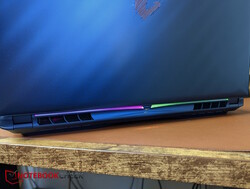
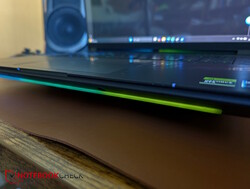
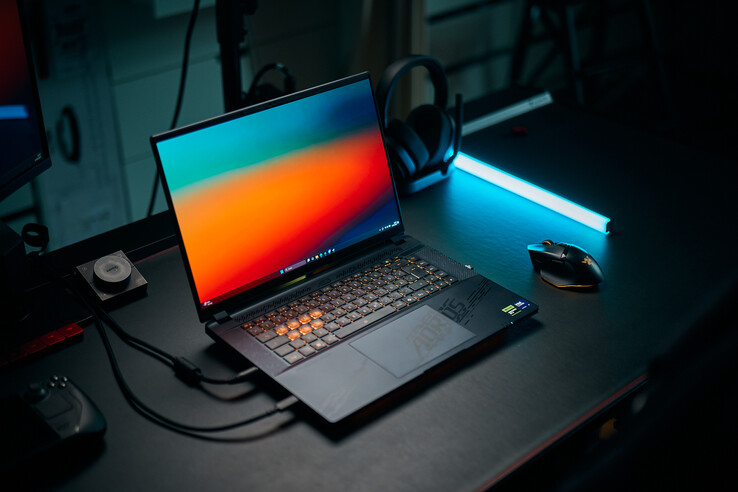













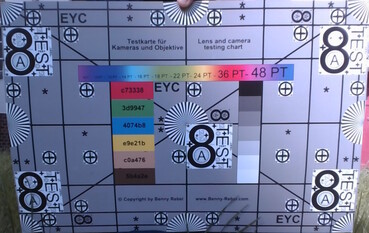

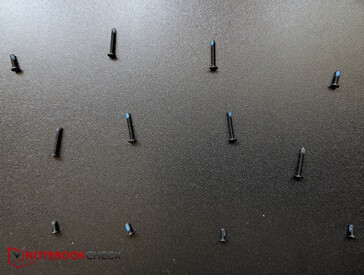

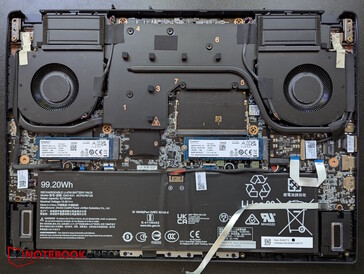

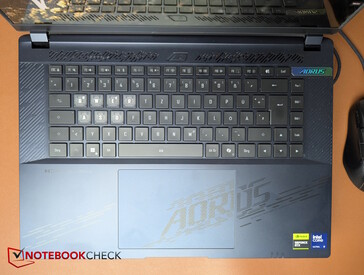
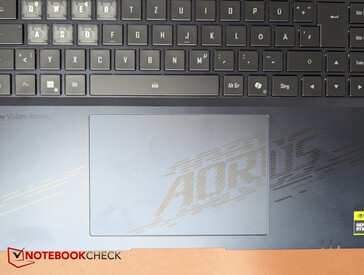
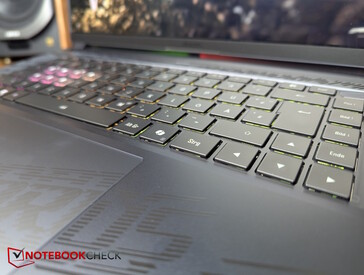


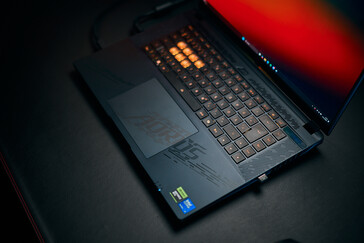
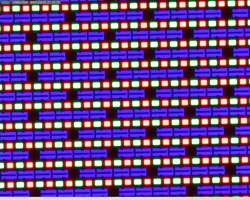
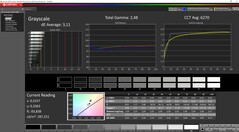
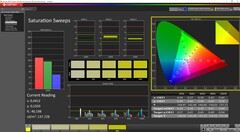


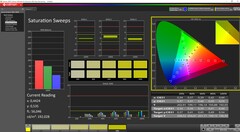
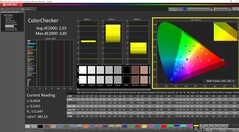

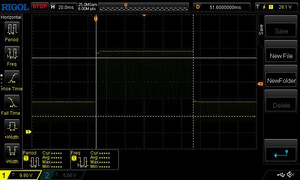
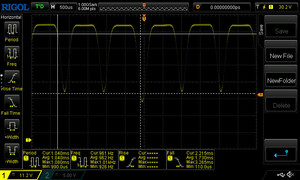





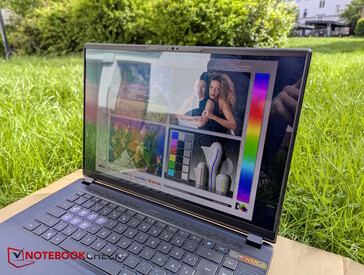



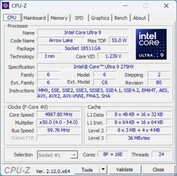

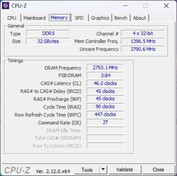
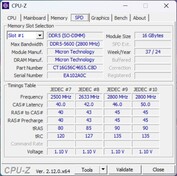
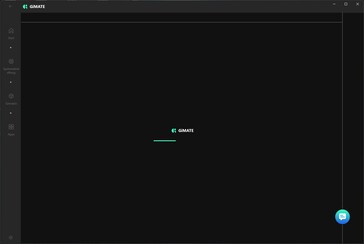
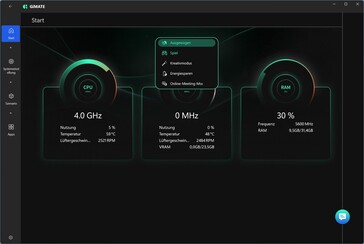

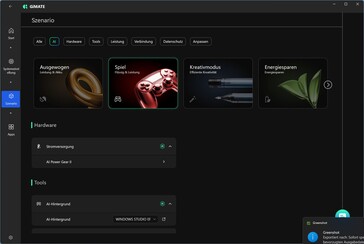
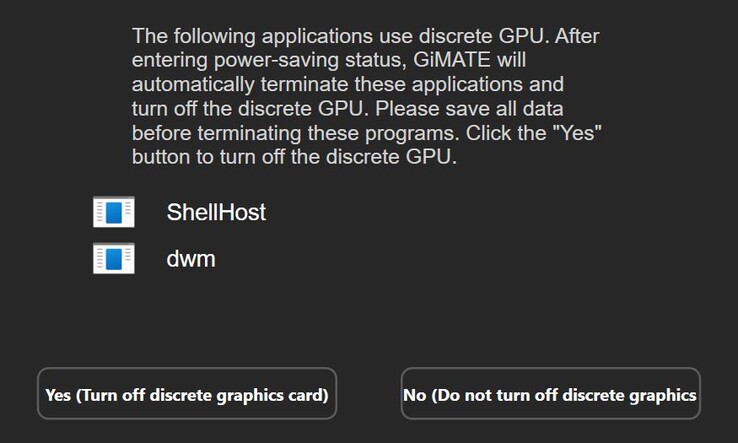





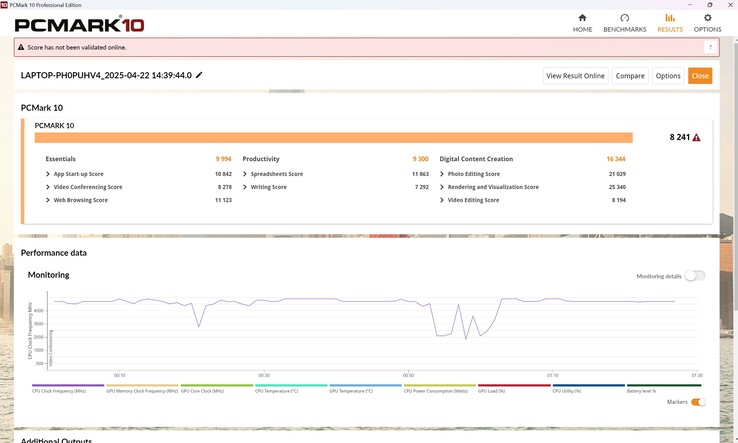
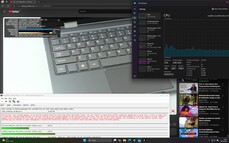
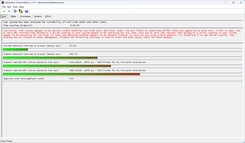


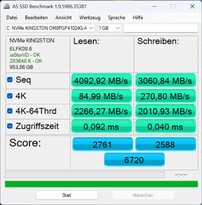
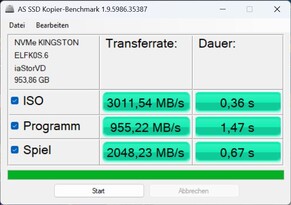






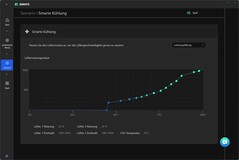
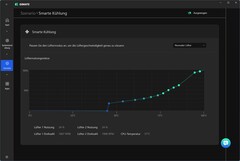
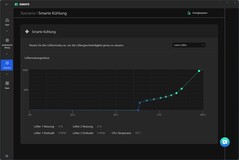

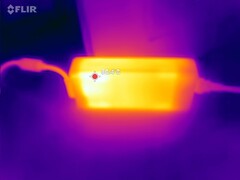

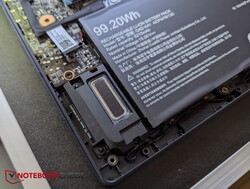
 Total Sustainability Score:
Total Sustainability Score: 






